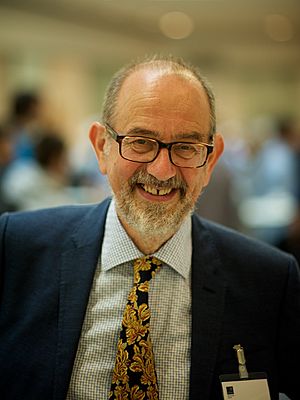Nigel Hitchin facts for kids
Quick facts for kids
Nigel Hitchin
|
|
|---|---|

Hitchin in 2016
|
|
| Born | 2 August 1946 Holbrook, Derbyshire, England
|
| Nationality | British |
| Education | Jesus College, Oxford (BA) Wolfson College, Oxford (DPhil) |
| Known for | Higgs bundle< ADHM construction Atiyah–Hitchin–Singer theorem Hitchin functional Hitchin's equations Hitchin–Thorpe inequality Kobayashi–Hitchin correspondence Nahm–Hitchin description of monopoles Generalized complex structure |
| Awards | Whitehead Prize (1981) Senior Berwick Prize (1990) Sylvester Medal (2000) Pólya Prize (2002) Shaw Prize (2016) |
| Scientific career | |
| Fields | Mathematics |
| Institutions | University of Oxford University of Warwick University of Cambridge |
| Doctoral advisor | Brian Steer Michael Atiyah |
| Doctoral students | Simon Donaldson Oscar Garcia Prada Tamás Hausel Jacques Hurtubise |
Nigel James Hitchin, born on August 2, 1946, is a famous British mathematician. He has done important work in many areas of mathematics, like differential geometry and mathematical physics. He is now a Professor Emeritus of Mathematics at the University of Oxford. This means he is a retired professor who still holds his title.
Nigel Hitchin's Education and Career
Nigel Hitchin went to Ecclesbourne School in Duffield, England. He then studied mathematics at Jesus College, Oxford, and earned his first degree in 1968. He continued his studies at Wolfson College, Oxford, where he received his Ph.D. in 1972. A Ph.D. is a high-level university degree.
After finishing his studies, he spent time at important research places. These included the Institute for Advanced Study and the Courant Institute of Mathematical Sciences in New York. He returned to Oxford as a research fellow. In 1979, he became a tutor and lecturer at St Catherine's College, Oxford.
In 1990, he became a professor at the University of Warwick. Later, in 1994, he was named the Rouse Ball Professor of Mathematics at the University of Cambridge. In 1997, he took on a very special role. He became the Savilian Chair of Geometry at the University of Oxford. He held this important position until he retired in 2016.
Key Discoveries and Ideas
Nigel Hitchin is known for many important discoveries in mathematics. He worked on ideas that help us understand shapes and spaces in new ways. Some of his key contributions include:
- The Hitchin–Thorpe inequality: This is a rule that helps mathematicians understand certain geometric shapes.
- Higgs bundles: These are special mathematical objects. They help solve complex equations in physics, especially those related to forces.
- The Hitchin system: This is a set of equations that are very useful in algebraic geometry. They help connect different areas of mathematics.
- Generalized complex structures: These are new ways to describe complex shapes. They combine different types of geometry into one idea. These ideas are used in string theory, which tries to explain how the universe works.
He also worked with other famous mathematicians on projects like the ADHM construction. This helps describe tiny particles called instantons. He and another mathematician, Shoshichi Kobayashi, also came up with a similar idea called the Kobayashi–Hitchin correspondence.
Nigel Hitchin has also guided many students in their research. He supervised 37 students, helping them become mathematicians themselves. One of his most famous students is Simon Donaldson.
Awards and Recognition
Nigel Hitchin has received many honors for his amazing work in mathematics.
- In 1991, he was chosen as a Fellow of the Royal Society. This is a very high honor for scientists in the UK.
- He received honorary degrees (Doctor of Science) from the University of Bath in 2003 and the University of Warwick in 2014. An honorary degree is given to someone to recognize their achievements.
- He was made an Honorary Fellow of Jesus College in 1998.
- He has won several important math prizes. These include the Senior Berwick Prize (1990), the Sylvester Medal (2000), and the Pólya Prize (2002).
- In 2016, he received the Shaw Prize in Mathematical Sciences. This is a very prestigious international award, sometimes called the "Nobel Prize of the East."
In 2012, he also became a fellow of the American Mathematical Society. A conference was held in Spain in 2006 to celebrate his 60th birthday.

